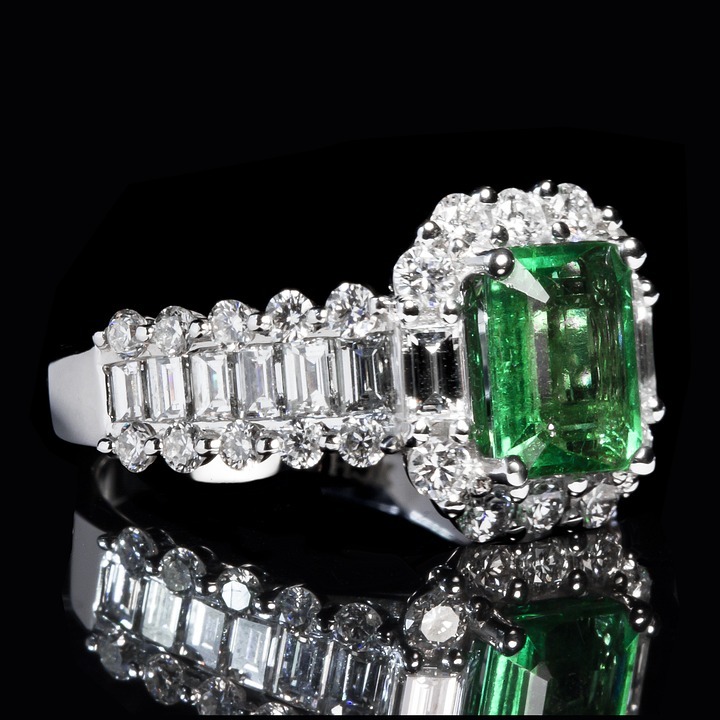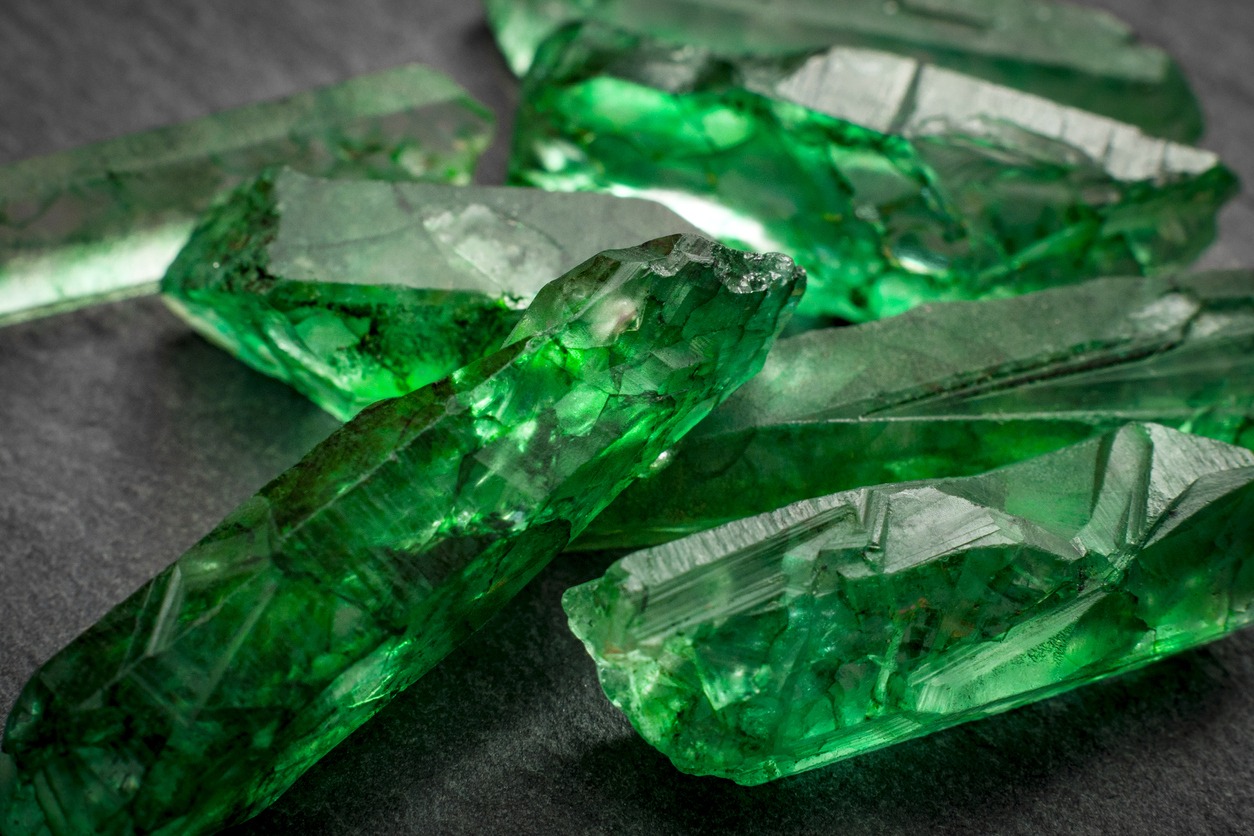Since ancient times, emerald has been linked to the color green. The beauty of a fine emerald justifies its place among the traditional “Big Four” gems, which also include sapphire, diamond, and ruby.
In this article, we will discuss emeralds and their various uses in jewelry.
What are Emeralds?
Emeralds are gem-quality specimens of the beryl mineral family that have a deep, distinctive green color. They can be discovered in a select few places around the world in igneous, metamorphic, and sedimentary rocks. The name we now know it as is thought to have originated from an ancient Persian word, translated to Latin as “smaragdus,” and eventually, over time, corrupted to “emerald.”
A medium to dark green to blue-green beryl gemstone, emeralds get their green color from chromium (Cr), vanadium (V), or a combination of the two. Before 1963, the term “emerald” only applied to beryls with chromium impurities, but this definition was changed in response to the discovery in Brazil of a sizable deposit of beryl stones that were vanadium-colored green. The modern definition states that an emerald is defined by the purity and saturation of the green color of the beryl.
Durability
The Mohs hardness of emerald is between 7.5 and 8, which is typically a very good hardness for jewelry use. The majority of emeralds, however, have numerous inclusions or fractures that reach the surface and may weaken, become brittle, or even become breakable. It is uncommon to find an emerald that does not have surface-reaching fractures and visible inclusions. Most emeralds are thought to have a “garden” of inclusions when viewed at low magnification.
A Brief History of Emerald
Emerald gemstones were mined in Egypt as early as 330 BC, but some estimate that the oldest emeralds are 2.97 billion years old.
The most well-known historical figure to treasure emeralds is Cleopatra. She even asserted ownership of each and every emerald mine in Egypt during her rule. The Egyptians incorporated emeralds into both their jewelry and their ornate funerals, frequently interring emerald stones with their monarchs as a sign of protection.
The Muzo Indians of Colombia, meanwhile, had highly valued and well-hidden emerald mines. It took the Spanish conquistadors almost twenty years to discover these mines because they were so well hidden.
According to Indian mythology, the name emerald was first translated from Sanskrit as “marakata,” meaning “the green of growing things.” As early as 4000 BC, according to historical records, the stone was well-known and available for purchase in markets in Babylon. The Incas worshiped this stone, and it is mentioned in biblical accounts of the apocalypse. The first mention of emeralds in Western literature comes from Aristotle. He was a huge proponent of the stone and maintained that possessing it increased one’s importance in appearance and speech when conducting business, brought success in trials, aided in the resolution of disputes, and comforted and soothed one’s eyesight.
Where can they be found?
South America is the hub of emerald mining, with Colombia and Brazil being the two main producers. Cleopatra’s passion’s source, the Egyptian mines, have long since run dry. However, thanks to mines in Ethiopia, Zambia, Zimbabwe, Madagascar, and Nigeria, Africa is currently the second-highest producer, trailing only South America. Every one of these locations usually yields a particular color, size, and clarity. Since 2016, Ethiopia has also produced some high-quality emeralds that don’t require oil treatments and have grass green to blue-green colors. Other notable emerald-producing regions are Afghanistan, Pakistan, Canada, Russia, and China.
What are Emeralds known for?
Emeralds are renowned for promoting creativity and eloquence, calming and balancing, and restoring faith and hope. They are used to arouse sympathy and kindness and are thought to bring good fortune. They are also used to enhance perception by strengthening one’s intuition. They represent love and bring truthfulness. It is said to detoxify negativity and transform it into positive emotional energy. It stabilizes, soothes, and offers a sense of security, harmony, and closeness to God. It increases one’s life purpose in relation to the universal plan and aids in emotional life and life transitions. It keeps the mind in excellent condition and also promotes a healthy memory.
Emeralds and Jewelry
The most expensive emeralds are those found in Colombia, where they can sell for $100,000 or more per carat depending on size and color. However, recent emerald discoveries in Ethiopia and Brazil are also commanding high prices. These gems can be used to make emerald rings, earrings, wedding bands, necklaces and pendants or bracelets.
Like many gemstones, the cost per carat of a fine quality emerald rises sharply with weight. For instance, according to a recent price guide, a fine quality 3-ct Colombian stone is worth six times as much as three 1-ct stones of equivalent quality.
Value factors are largely dependent on color, with subtle differences in saturation and hue having a significant impact on price. The most appealing color is a medium dark, slightly bluish green with strong to vivid saturation.
How to spot an authentic emerald
If an emerald with an extremely vivid and intense shade of green, exceptional cleanliness, and the same brilliant luster visible on a natural emerald of much greater quality costs only USD $500 (or less) per carat, you may be looking at a lab-created emerald as the price seems suspiciously low. Beware that some dishonest sellers may deceive unaware clients by providing imitation emeralds at regular “real emerald” prices.
Always inquire as to the origin of the emeralds you are intending to buy. Request a 10x loupe, a bright light, or a good magnifying glass from the seller. It may be a natural emerald if you spot tiny flaws or atypical patterns in the stone, as well as (this is a crucial detail) small natural holes or tiny deep lines, particularly in the pavilion (the backside) of the gemstone. Make sure to look for air bubbles because they are typically absent in natural emeralds.
Fun facts about emeralds
- As the birthstone for May, the emerald, a symbol of rebirth, is believed to grant the owner foresight, good fortune, and youth. It is also considered the traditional 55th wedding anniversary stone.
- Emeralds are said to be abundant in King Tut of Egypt’s tomb, which is the only intact royal burial discovered in recent memory.
- A votive crown originally created for a larger-than-life size statue of the Virgin Mary in the cathedral of Popayán, Colombia, is known as the Crown of Our Lady of the Assumption of Popayán or the Crown of the Andes. The largest of the 450 emeralds on the crown, the Atahualpa Emerald, may have belonged to the Incan Emperor Atahualpa (1497-1533), who was captured by a Spanish conquistador named Francisco Pizarro in 1532 and taken as a prisoner.
- One of the Indian moguls who was responsible for the construction of the Taj Mahal, Shah Jahan, was so enamored of emeralds that he had religious texts inscribed on them and wore them as talismans.
- According to the Guinness Book of Records, the largest emerald (in matrix) was found in Madagascar. It is 1.25 m long and weighs 536 kg.


